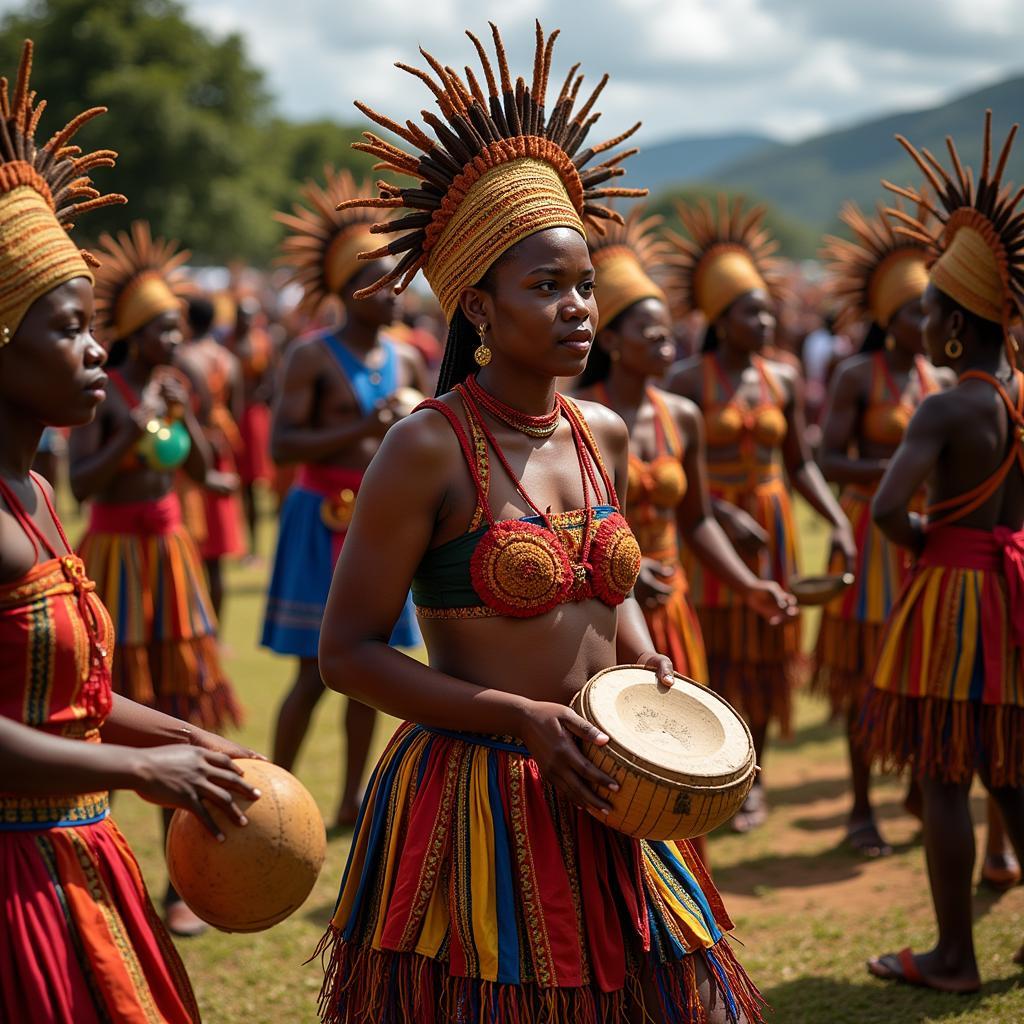The Rhythmic Echoes: African Influence on Latin American Music
The vibrant tapestry of Latin American music is undeniably interwoven with threads of African rhythms, melodies, and instruments. This African Influence On Latin American Music is a testament to the complex historical relationship between the two continents, a legacy etched in the heart of musical traditions across the Americas. From the syncopated beats of salsa to the soulful strains of cumbia, the African diaspora has left an indelible mark on the soundscapes of Latin America.
Tracing the Roots: How African Music Arrived in Latin America
The transatlantic slave trade tragically brought millions of Africans to the Americas, including Latin America. These individuals, forcibly removed from their homelands, carried with them their rich musical heritage. This cultural transmission, despite the horrors of slavery, formed the bedrock of numerous Latin American musical genres. Music became a source of solace, resistance, and cultural preservation for enslaved Africans, evolving and merging with indigenous and European musical forms over time. Early forms of religious music, work songs, and social gatherings provided platforms for the expression of African musical traditions, setting the stage for the development of distinct Afro-Latin musical styles. The specific instruments, rhythms, and vocal styles varied depending on the region and the specific African cultures represented. For example, the Yoruba and Bantu peoples had a significant impact on the music of Cuba and Brazil.
One particular aspect of African influence is evident in the rhythmic complexity found in many Latin American genres. Polyrhythms, the simultaneous use of two or more contrasting rhythms, are a hallmark of African music and can be heard in genres like rumba, salsa, and samba. These intricate rhythmic patterns create a dynamic and layered soundscape, reflecting the richness and depth of African musical traditions. The call-and-response vocal structure, another common feature of African music, also found its way into numerous Latin American musical forms. This dynamic exchange between a lead singer and a chorus creates a sense of community and participation, echoing the communal nature of African musical expression.
African immigration to Latin America has significantly shaped the musical landscape.
The Heartbeat of the Music: Key Instruments and Rhythms
The rhythmic backbone of many Latin American musical styles can be traced back to African instruments. Drums, in particular, play a crucial role. The conga, bongo, and batá drums, all with African roots, provide the driving force behind genres like rumba, salsa, and Afro-Cuban religious music. These instruments, often played in complex polyrhythmic patterns, infuse the music with an infectious energy and vitality. Similarly, the use of percussion instruments like the claves, shekere, and agogô bells adds intricate layers of rhythm and texture, reflecting the sophisticated rhythmic sensibilities of African music.
African belly dance also shows the rhythmic complexity and body movement often found in Latin American dance forms.
Beyond the rhythmic foundations, the melodic and harmonic elements of Latin American music also bear the imprint of African influence. The use of pentatonic scales, common in many African musical traditions, can be heard in various Latin American genres. The bluesy inflections and soulful vocal styles often found in genres like cumbia and son also resonate with the expressive qualities of African musical traditions. The blending of these musical elements created a unique hybrid sound, reflecting the complex cultural interactions that shaped Latin American societies.
 Candomblé Ceremony in Bahia, Brazil
Candomblé Ceremony in Bahia, Brazil
From Candomblé to Carnival: African Influence in Specific Genres
The African influence on Latin American music is not monolithic; it manifests in diverse ways across different genres and regions. In Brazil, the rhythms and rituals of Candomblé, an Afro-Brazilian religion, have profoundly shaped musical traditions like samba and capoeira. The syncopated rhythms, call-and-response singing, and use of percussion instruments in these genres reflect the deep connection to African musical heritage. Similarly, in Cuba, the rhythms of Yoruba and Bantu music have given rise to genres like rumba, son, and salsa, each with its distinct character and flavor. These genres, often associated with social dance and celebration, embody the vibrant energy and rhythmic complexity of African musical traditions. Moreover, the influence extends to other genres like cumbia in Colombia, plena in Puerto Rico, and bachata in the Dominican Republic, each reflecting the unique cultural blending within these specific regions.
African American voodoo shares some similarities with Candomblé in its blend of African and other religious traditions.
How Has African Music Impacted Latin American Music Today?
The influence of African music continues to resonate in contemporary Latin American music. Modern artists often draw upon these rich traditions, incorporating elements of African rhythms, instrumentation, and vocal styles into their music. This ongoing dialogue between past and present ensures that the legacy of African music remains a vital force in shaping the soundscapes of Latin America. The fusion of traditional African rhythms with modern electronic music, for example, has created exciting new sounds that push the boundaries of Latin American music. This constant evolution and innovation demonstrate the enduring power and adaptability of African musical influences.
Conclusion: A Lasting Legacy of Rhythm and Soul
The African influence on Latin American music is a powerful testament to the resilience and creativity of the human spirit. From the shores of West Africa to the vibrant streets of Havana and Rio de Janeiro, the rhythmic echoes of Africa continue to resonate in the heart of Latin American music. This rich musical heritage, born from a history of both tragedy and triumph, has shaped the soundscapes of the Americas, enriching the global musical landscape with its vibrant rhythms and soulful melodies. The African influence on Latin American music reminds us of the interconnectedness of cultures and the enduring power of music to transcend boundaries.
FAQ
- What are some key instruments of African origin used in Latin American music? Congas, bongos, batá drums, claves, shekere, and agogô bells.
- What is the significance of polyrhythms in Afro-Latin music? Polyrhythms create complex and dynamic rhythmic textures, a hallmark of African musical traditions.
- How did the transatlantic slave trade impact Latin American music? It brought enslaved Africans and their musical traditions to the Americas, forming the basis for many Afro-Latin genres.
- What are some examples of Afro-Brazilian religious music? Candomblé music, which has influenced genres like samba and capoeira.
- Which African cultures had a significant impact on Cuban music? Yoruba and Bantu cultures.
You may also be interested in learning about African ballroom dance hip moves.
For further information on related topics, please visit our articles on African countries in the southern hemisphere.
If you need any further assistance, please contact us via Phone: +255768904061, Email: kaka.mag@gmail.com or visit our office at Mbarali DC Mawindi, Kangaga, Tanzania. We have a 24/7 customer service team available to help.

